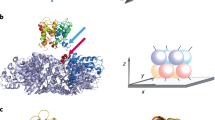Abstract
For our investigations on orientational motions of membrane proteins with the method of time-resolved fluorescence anisotropy decay (TRFA), we first wanted to test the use of tryptophan fluorescence in detecting slow motions on the time scale of tens of nanoseconds and to get more insight into the possible motions of membrane proteins by investigating a simple system. We performed TRFA measurements on a short α-helical 21-amino acid peptide in different environments (Vogel, H.,et al. Proc. Natl. Acad. Sci. USA 85, 5067–5071, 1988). In each case, we got three relexation time constants. The longest of these depends strongly on changes in the environment, whereas the two shorter times show only weak dependencies. So we conclude that the longest time belongs to the rotational diffusion of the entire peptide and the other to internal motions.
Similar content being viewed by others
Author information
Authors and Affiliations
Rights and permissions
About this article
Cite this article
Döring, K., Beck, W. & Jähnig, F. On the use of tryptophan to detect slow orientational motions. J Fluoresc 4, 337–338 (1994). https://doi.org/10.1007/BF01881451
Received:
Issue Date:
DOI: https://doi.org/10.1007/BF01881451




